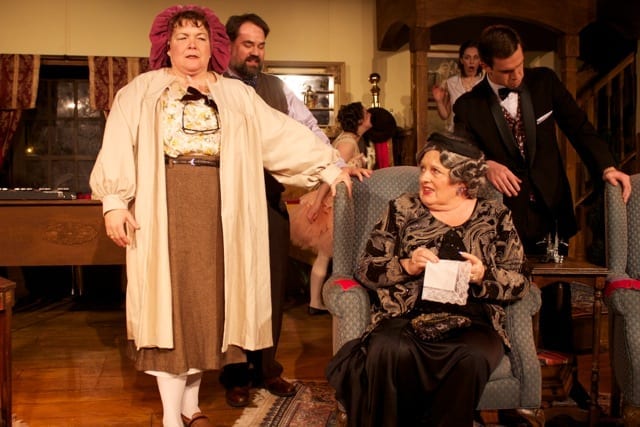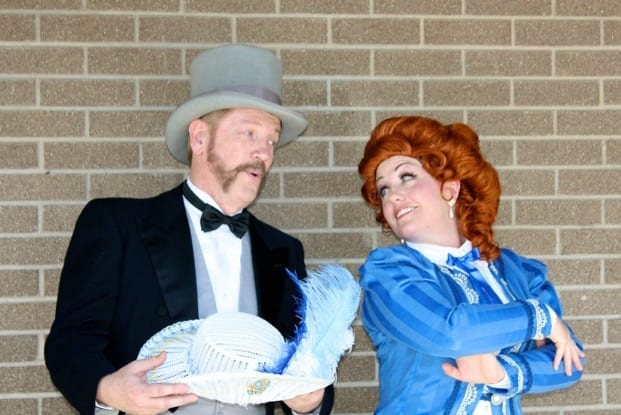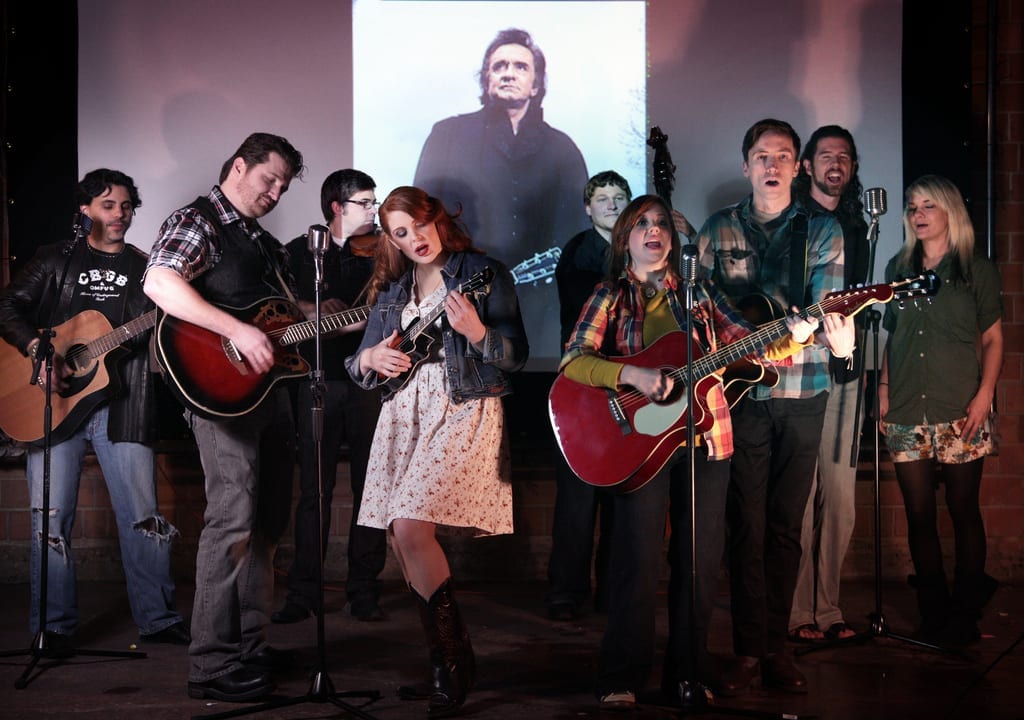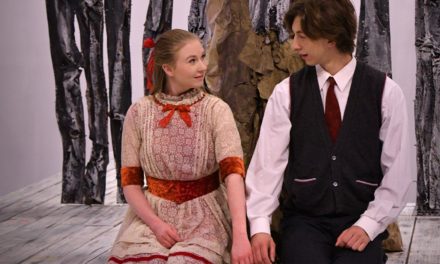LEHI — Everyone has an eccentric relative that embarrasses them in public. Maybe it’s the strange uncle who has a hobby collecting odd objects like foreign Coke bottles. Perhaps it’s your grandparents who grew up during the Depression, which makes them have trouble throwing anything away. Or perhaps you’re like Alice Sycamore, who has more than just one or two odd relatives—and you have an entire family of them.

Marc Haddock as Martin Vanderhof and Lacey Jackson as Alice Sycamore. Show closes April 15, 2013. Photo by Kim Fillmore of Filly Fotos.
You Can’t Take It With You is Moss Hart and George S. Kaufman‘s classic comedy about the Sycamores—a group where nuttiness runs in the family for three generations. The only normal member of the family, granddaughter Alice Sycamore (played by Lacey Jackson), brings her beau, Tony Kirby (played by Evan Meigs), to her home after they have been dating for a few months. Tony meets the family and, surprisingly, isn’t put off by their eccentricities. Alice and Tony make plans to bring his wealthy high society parents to meet the Sycamores, but a mixup occurs and Tony’s parents show up on the wrong evening—and in the middle of the the zenith of the Sycamores’ craziness.
Although this script is many people’s favorite and a staple of the high school and college stage, You Can’t Take It With You has the potential to become a play full of plodding dialogue punctuated by a few moments of action. I’m pleased to report, though, that under the guidance of director Andrew Lloyd Hunsaker, this production has swift pacing and never gets bogged down in the plot cul-de-sacs or lengthy exposition. Andrew Hunsaker also took care to establish the peculiarities of each character, which makes some of the more frantic moments of the story more enjoyable. I also like the little stage business that Andrew Hunsaker had the actors engage in when they were not the center of attention. All of these little side actions (such as the interactions between Paul and Mr. De Pinna at the kitchen table) helped establish character and made the interactions among the characters feel more real. Finally, I commend Andrew Hunsaker on his careful planning of the play’s funniest moments, such as when Mr. Henderson arrived at the house. Such carefully choreographed chaos shows that Andrew Hunsaker clearly understand that in a play like You Can’t Take It With You, genuine humor is no accident.
Hunsaker’s efforts would be wasted if he did not have actors capable of doing justice to his vision and the script. Chief among these is Lacey Jackson, who played Alice with a sweet sincerity that made it believable that because they were family, she loved the very people who drove her nuts. In the hands of a lesser actress the story would feel pointless because it would look like Alice is stupid for using Tony as her ticket out of her intense home life. Opposite Jackson was Evan Meigs as the rich, dashing Tony Kirby. Meigs played Tony like an uneasy intruder in the Sycamore home, always trying to accept the antics around him because he doesn’t want to offend the woman he loves. I especially loved Meigs’s grin, which to me felt like Tony was just trying to smile his way through the ordeal of meeting the Sycamores.
My favorite actors who played the family members and hangers-on were probably Jan Shelton Hunsaker and Gretchen Monson. Jan Hunsaker played Penelope Sycamore, Alice’s mother who is always writing plays, none of which were ever finished, let alone produced. Instead of an odd quirk, I saw that Penelope had a “joy in the journey” viewpoint of her hobby—a refreshing take on the character. Monson was excellent in showing Essie as a flighty girl who lives in the moment and simply enjoy being herself. This aspect of the character was very apparent when Essie forgot to give her grandfather his mail and when she was oddly attentive to Tony when she first met him.

Lacey Jackson (seated) as Alice Sycamore, Evan Meigs as Tony Kirby, and Jacob Haight as Donald. Photo by Kim Fillmore of Filly Fotos.
I also appreciated the performances from Marc Haddock as Martin Vanderhof, Penelope’s father and Alice’s grandfather. Haddock is comfortable in the role of a family patriarch. More importantly, Haddock avoids the trap the trap of making Martin odd for the sake of oddness. Rather, Haddock shows—especially in the final scene—that Martin’s oddness (and, in turn, the rest of the family’s) has a very rational basis. Finally, Steve Aaron was an enjoyable Boris Kolenkhov, a Russian immigrant who drifted into the family as Essie’s dance instructor and now regularly joins the family for dinner. Aaron resisted the urge to steal the scene and make his character larger than life. Rather, he played a very human Kolenkhov, who was sympathetic (especially in his scenes with Olga, played by Allison Books) and therefore the sort of person that kind people like the Sycamores would take into their home. Plus, Aaron had a great Russian accent, to boot.
The set (designed by Jerry Hatch, Andrew Lloyd Hunsaker, and Jan Shelton Hunsaker) made good use of the small stage in the Lehi Arts Center without making the stage feel crowded. And it was full of wonderful details, like a small printing press and a period typewriter. The lighting (designed by Chase Elison) was not showy, but it reminded me why the Lehi Arts Center is one of my favorite small venues in Utah County. Finally, Crystal Denton’s costumes were all appropriate for the period, helped emphasized characters’ traits, and emphasized their distinctiveness. There was no danger, for example, of mixing up Ed (played by Chad Taylor) and Boris, because they were both dressed in such an individualistic style. On the other hand, some of the men’s suits seemed to be directly from the actors’ closets. I wouldn’t normally mind this in an arts council production, but it was such a contrast from all of the other excellent period clothes that it was a little visually odd.
I’ve said plenty of positive things about this production, but it probably won’t be my favorite play that I see this year. That’s because there are aspects of Hart and Kaufman’s script that bother me. I don’t like how many unnecessary characters there are in it, nor do I like the fact that even this tight production runs nearly two and a half hours. But it’s very illustrative of the type of plays that were hugely popular in the 1930’s, and which still endure today. I think that Lehi Arts Council, however, has a successful production on their hands, and both the family crowd and the date crowd in Utah County would enjoy the production.






